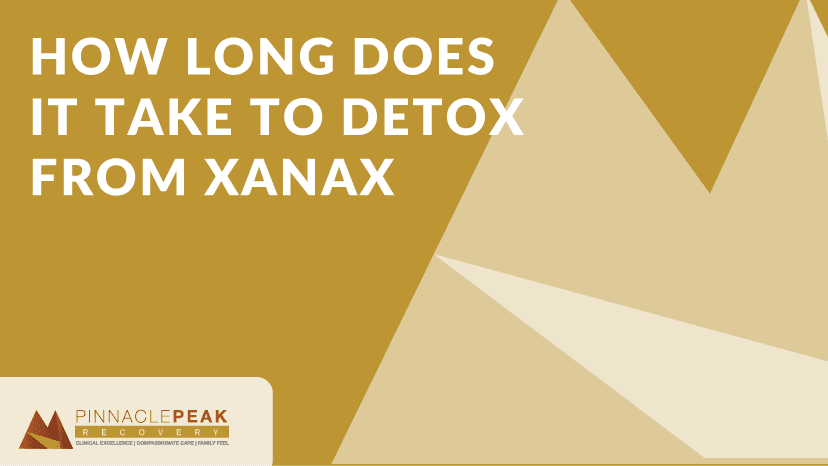Over 6 million people reported misusing prescription medications like Xanax in 2020. In addition to this, over 40% of adults in Arizona reported feeling symptoms of anxiety or depression in 2021. While it isn’t used to help with depression, Xanax isn’t uncommon in helping treat things like panic attacks for those managing anxiety. Between the two of these statistics, a not-so-small portion of Americans, and Arizonians, have probably taken Xanax at some point in their lives. Whether you’re on a prescription or have taken it outside of medical advice, you might want to know how long does it take to detox from Xanax?
With the trend of people taking substances like Xanax outside of medical advice, we here at Pinnacle Peak Recovery believe in continuing to educate our community about substances. With proper information regarding substance use, we hope to arm our community with the knowledge to help themselves and others as needed. Being able to find reliable information regarding substance use only benefits others, letting them make informed decisions about their health when they need it most.
How Long Does the Xanax Detox Process Take?
You might’ve heard about detoxing before, though the first thing that comes to mind might be a detox tea, or other diets involving “flushing” or “cleansing” the body. When it comes to substance use, drinks and diets won’t fix everything, but the process is still similar. The goal of a Xanax detox is to help get the substance fully out of your body.
The amount of time it takes for Xanax to pass entirely through the body depends on a few things. First, it’s important to know what a half-life is, as this is how the length of time a substance is in someone’s body is measured, divided in half. Secondly, things like age, metabolism, history of substance use, and the other substances you have in your body can impact the amount of time it takes for a substance to leave the body.
Xanax is a short-acting benzodiazepine, meaning it usually isn’t in the body for a very long time. There are forms of Xanax, however, known as extended-release tablets that can lengthen this amount of time. Generally speaking, the average half-life of Xanax is about 11 hours.
Xanax Withdrawal Symptoms and Side Effects
Withdrawal varies from substance to substance. In the case of Xanax, even people taking it as prescribed can experience withdrawal symptoms. Because of this, many doctors will taper you off of Xanax instead of having you quit cold turkey. Why does this happen?
When the body often has a substance or medication inside of it that alters your system in an impactful way, it can adjust to its presence and the role that it’s playing – regardless of how truly helpful that role may be. If you were to suddenly remove this substance from your body, this can cause it to go into shock, causing you to experience withdrawal. Due to how short the half-life of Xanax is, the body doesn’t get as much time to adjust to its absence. This is why Xanax has a high withdrawal rate.
Physical Withdrawal Symptoms
Even though Xanax is a depressant, meaning it primarily affects your brain and central nervous system, you can still experience physical side effects when going through Xanax withdrawal. Some of the more common physical withdrawal symptoms include vertigo, blurry vision, nausea, vomiting, tingling sensation on your skin, cramps, and tinnitus (ringing in your ears).
In extreme cases, or if you were taking Xanax as a way to manage a seizure disorder, you might experience seizures as a side effect as well.

Psychological Withdrawal Symptoms
When you’re taking a prescription to help manage symptoms, it’s not uncommon for those symptoms to be a part of withdrawal. Because Xanax was helping manage the symptoms, those symptoms can flare up again when you stop taking it. Since Xanax is commonly used to help with panic attacks, they’re a common side effect of withdrawal.
Other psychological side effects include delusions, hallucinations, and memory loss.
Xanax Withdrawal Timeline
The start time of withdrawal will vary depending on the half-life of your specific dosage of Xanax. Overall, this timeline isn’t going to be verbatim, but it can give you a good idea of what to expect or look out for when it comes to Xanax withdrawal.
- Days 1-3 – Symptoms of withdrawal can start appearing within several hours of your last dose. These first four days tend to be the most intense and have the highest risk for some side effects like seizures. Cravings, mood swings, insomnia, and nausea are incredibly common and persistent during these first four days as well.
- Days 4-9 – The more intense symptoms start to simmer down after the first 72 hours have passed. This doesn’t mean they’re gone, however. Symptoms such as insomnia and cravings will persist. Many people notice increased irritability and changes in their normal heart rate, as well as symptoms of depression during this time.
- Days 10-18 – Many of the more physical symptoms are usually dissipated by this stage of withdrawal, psychological symptoms, however, tend to persist. Depression, mood changes, and anxiety are commonly still a concern. These symptoms could persist for longer than 18 days but can be managed with proper treatment.
What Factors Lead to Xanax Misuse?
There are many factors that can contribute to substance misuse. It’s important to know that misuse can even happen unintentionally. Any time a prescription is taken outside of their directions, it’s considered misuse.
One of the common reasons people take substances is to manage other things going on in their life. Whether they see the substances as an escape, or they’ve noticed a change in their behavior when taking those substances that they like, there’s usually more behind it than simply deciding to take it one day. Some may even take it because they’ve heard about what it’s used for, in the case of Xanax maybe they heard it works for panic attacks, but they don’t want to go to a doctor so they acquire it through other means.
In addition, it’s not uncommon for those regularly partaking in other substances, like opioids, for example, to decide to try other substances as well. They might’ve heard about the combination being “fun,” or perhaps they’d tried both separately and wanted to feel their effects combined. Unfortunately, this can lead to an increased risk of overdose. Benzodiazepines and opioids, in particular, are a combo that was found in over 7% of overdoses in Arizona in 2021.
Finally, another common reason for misuse is experiencing a lessening of the effects they used to experience when taking their medication. Some might think that increasing their dosage can help solve the problem, only to potentially add to it in the long run.
Complications That May Occur During Xanax Detox
If you are already managing a seizure disorder and are using Xanax to do so, talk to your doctor before you try to quit your medication. Seizures can lead to further complications depending on their severity, such as long-term injury.
Other xanax side effects you might experience, such as hallucinations and delusions, can potentially cause harm to yourself or others as you react to situations that aren’t real.
If you start noticing any of the signs of withdrawal we talked about today, don’t be afraid to reach out for help. Here at Pinnacle Peak, we’re happy to ensure your recovery goes as smoothly as possible.
Getting Xanax Addiction Treatment in Scottsdale
If you or a loved one is looking to begin healing from benzo use, we’re here and ready to assist. We offer everything from detox services to inpatient and outpatient programs. We understand that our clients are all unique, which is why we offer everything from the 12-step program to evidence-based alternatives such as music therapy. This allows you to find the steps that will best fit your recovery journey.
If you have any questions about our Arizona addiction treatment programs, treatment options, or anything else, don’t hesitate to give us a call today at (866) 377-4761.
Call To Talk To One Of Our Professionals Today!
FAQs About How Long Does It Take To Detox From Xanax
Can you quit Xanax cold turkey?
Quitting Xanax “cold turkey” can lead to intense withdrawal symptoms such as vomiting, hallucinations, panic attacks, and even seizures.
Is Xanax withdrawal dangerous?
Xanax withdrawal is not often dangerous, but it can be intense. Many times, the first 72 hours are the worst.
Is Xanax addictive?
Xanax itself isn’t addictive, but it has a high risk of people experiencing withdrawal when they don’t take it. This can lead to cravings, which can encourage continued consumption.

